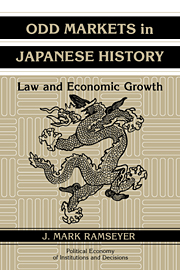Book contents
- Frontmatter
- Contents
- List of tables
- Series editors' preface
- Acknowledgments
- INTRODUCTION
- CHAPTER 1 LAW AND ECONOMIC GROWTH
- CHAPTER 2 PROPERTY: WATER AND LAND
- CHAPTER 3 EXTERNALITIES: SMOKE AND NOISE
- CHAPTER 4 MARKETS: CHILDREN
- CHAPTER 5 AUTONOMY: FAMILY LAW
- CHAPTER 6 PROMISSORY CREDIBILITY: SEX
- CHAPTER 7 CARTELS: COTTON SPINNING
- CHAPTER 8 CONCLUSIONS
- References
- Index
- POLITICAL ECONOMY OF INSTITUTIONS AND DECISIONS
CHAPTER 6 - PROMISSORY CREDIBILITY: SEX
Published online by Cambridge University Press: 21 September 2009
- Frontmatter
- Contents
- List of tables
- Series editors' preface
- Acknowledgments
- INTRODUCTION
- CHAPTER 1 LAW AND ECONOMIC GROWTH
- CHAPTER 2 PROPERTY: WATER AND LAND
- CHAPTER 3 EXTERNALITIES: SMOKE AND NOISE
- CHAPTER 4 MARKETS: CHILDREN
- CHAPTER 5 AUTONOMY: FAMILY LAW
- CHAPTER 6 PROMISSORY CREDIBILITY: SEX
- CHAPTER 7 CARTELS: COTTON SPINNING
- CHAPTER 8 CONCLUSIONS
- References
- Index
- POLITICAL ECONOMY OF INSTITUTIONS AND DECISIONS
Summary
INTRODUCTION
Few industries tug as strongly at the heartstrings as the sexual services industry. Take the tales social historian Mikiso Hane tells. A “growing chasm” separated rich and poor in pre-War Japan (1982, 34), he writes. “[T]he condition of the peasants remained pathetic in contrast with the growing well-being of bourgeois capitalists,” and peasants found themselves waging “a bitter struggle for survival” (id., at 31, 27). Within this impoverished world, some of “the most pitiful victims …were the young farm girls who were sold to brothels” (id., at 207).
Unfortunately, the poignancy masks the ingenuity with which prostitutes and brothel owners overcame the chronic informational asymmetries in the contracting process. In most industries, prospective employees know their own productivity better than employers; employers know their own operations better than employees; both have an incentive to lie; and both would do best if both could communicate honestly. Given that most employers and employees care what others say about them, reputational effects mitigate some of these problems. Often, however, employers and employees can – and do – draft labor contracts to reduce any remaining informational problems. In the sexual services industry, they drafted those contracts with a remarkable resourcefulness.
In the following two chapters, I consider two issues central to the thesis in this book: narrowly – how did workers and employers respond to such informational asymmetries in the labor market; and more broadly – how independently and selfishly did they behave? To explore these questions, I study two very different industries.
- Type
- Chapter
- Information
- Odd Markets in Japanese HistoryLaw and Economic Growth, pp. 109 - 134Publisher: Cambridge University PressPrint publication year: 1996



